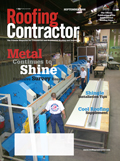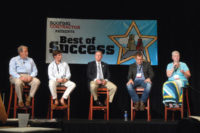


Atlanta-based
Mid-South Roof Systems Inc. produces a wide variety of metal building
components in the company’s state-of-the-art metal shop. Production is split
between their own roofing projects and work performed for other building and
roofing contractors. (Photos by Rick Damato.)
The Sample Surveyed
The audience was comprised of 1,476 active, qualified Roofing Contractor subscribers selected at random, and the survey had a healthy response rate of 18 percent. Ninety-seven percent of respondents were responsible for specifying, recommending, or purchasing metal roofing products for their company.

Gauging the Market
Contractors were asked whether they expected their residential and commercial business to increase, decrease or stay about the same in the next 12 months and three years. (See Figures 1 and 2.) Sixteen percent of respondents expected residential sales revenue to decline in the next year. That figure was twice as large as that in the 2005 study (8 percent) and three times as large as in 2001 (4 percent). However, 84 percent of respondents expect residential business to increase or stay about the same during the next 12 months.


Types of Metal Roofing Materials Used
When we asked about types of commercial and residential metal roofing materials used, galvalume was the top response in both categories. (See Figures 3 and 4.) On average, 23 percent of respondents indicated they used galvalume for residential applications - up 10 percent from the 2005 study. The use of galvalume in commercial roofing also saw a substantial gain compared to the 2005 study. A quarter of this year’s respondents indicated they used galvalume for commercial applications, compared to 13 percent in 2005. Aluminum and galvanized also saw notable increases over the most recent study in both the residential and commercial categories.


Purchase History, Buying Plans
Survey respondents were asked how much they spent on metal roofing equipment and machinery in the last 12 months and how much they planned to spend in the next 12 months. (See Figures 5 and 6.) On average, respondents spent $17,280 on metal equipment and machinery in the past 12 months, and they planned to spend $14,607 in the next 12 months.


Report Abusive Comment